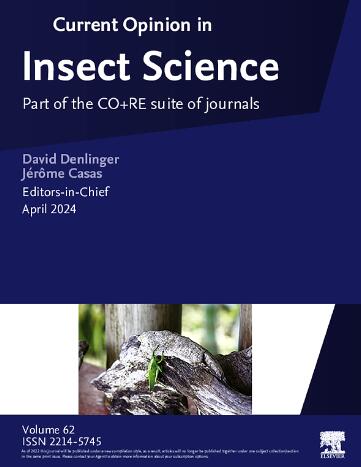Juvenile hormone signaling and social complexity in the Hymenoptera
IF 4.8
1区 农林科学
Q1 BIOLOGY
引用次数: 0
Abstract
The seminal discovery that in adults of the highly social honey bee (Apis mellifera), juvenile hormone (JH) regulates age-related division of labor (DoL) but not adult fertility, unlike in most insects, has led to the hypothesis that the evolution of insect sociality involved modifications in JH signaling. Recent studies examining JH functions across the Hymenoptera provide two main insights: First, significant progress in studies of the bumble bee Bombus terrestris, which exhibits an intermediate level of social complexity relative to honey bees, shows that JH regulates multiple tissues involved in reproduction, but not task performance. JH also seems to function as a primary gonadotropin in bees showing solitary lifestyles or low levels of social complexity, highlighting a marked contrast with its roles in honey bees. Second, this association between JH function and social complexity in bees does not generalize to other lineages. The few studies on JH function in highly social stingless bees are not consistent with the honey bee model. In wasps and hornets, JH typically influences both fertility and age-related DoL. There is substantial variability across ant species, offering no consistent model linking JH function to social complexity. We propose that although JH signaling is commonly modified in social insects, the specific changes differ between — and sometimes within — lineages. There is no one model linking JH function to social complexity across major lineages, likely due to changes in related pathways. These modifications enable social insects to circumvent the trade-off between reproduction and maintenance.
膜翅目昆虫的幼虫激素信号传导与社会复杂性。
在高度社会化的成年蜜蜂(Apis mellifera)中,幼体激素(JH)调节与年龄相关的劳动分工(DoL),而不是成年的生育能力,这一开创性的发现与大多数昆虫不同,导致了昆虫社会性进化涉及JH信号改变的假设。最近对膜翅目JH功能的研究提供了两个主要的见解:首先,对大黄蜂Bombus terrestris的研究取得了重大进展,它表现出相对于蜜蜂的中等社会复杂性,表明JH调节涉及生殖的多个组织,但不包括任务表现。JH在独居生活或社会复杂性较低的蜜蜂中似乎也是一种主要的促性腺激素,这与它在蜜蜂中的作用形成了鲜明的对比。其次,蜜蜂的JH功能和社会复杂性之间的这种联系并不适用于其他谱系。少数关于高度群居无刺蜜蜂JH功能的研究与蜜蜂模型不一致。在黄蜂和大黄蜂中,JH通常会影响生育能力和与年龄相关的DoL。蚂蚁种类之间存在很大的差异,没有一致的模型将JH功能与社会复杂性联系起来。我们认为,虽然群居昆虫的JH信号通常会发生改变,但具体的变化在不同的谱系之间是不同的,有时在不同的谱系内也是不同的。没有一个模型将JH功能与主要谱系的社会复杂性联系起来,这可能是由于相关途径的变化。这些变化使群居昆虫能够避免繁殖和维持之间的权衡。
本文章由计算机程序翻译,如有差异,请以英文原文为准。
求助全文
约1分钟内获得全文
求助全文
来源期刊

Current opinion in insect science
BIOLOGYECOLOGYENTOMOLOGY-ECOLOGY
CiteScore
10.40
自引率
1.90%
发文量
113
期刊介绍:
Current Opinion in Insect Science is a new systematic review journal that aims to provide specialists with a unique and educational platform to keep up–to–date with the expanding volume of information published in the field of Insect Science. As this is such a broad discipline, we have determined themed sections each of which is reviewed once a year.
The following 11 areas are covered by Current Opinion in Insect Science.
-Ecology
-Insect genomics
-Global Change Biology
-Molecular Physiology (Including Immunity)
-Pests and Resistance
-Parasites, Parasitoids and Biological Control
-Behavioural Ecology
-Development and Regulation
-Social Insects
-Neuroscience
-Vectors and Medical and Veterinary Entomology
There is also a section that changes every year to reflect hot topics in the field.
Section Editors, who are major authorities in their area, are appointed by the Editors of the journal. They divide their section into a number of topics, ensuring that the field is comprehensively covered and that all issues of current importance are emphasized. Section Editors commission articles from leading scientists on each topic that they have selected and the commissioned authors write short review articles in which they present recent developments in their subject, emphasizing the aspects that, in their opinion, are most important. In addition, they provide short annotations to the papers that they consider to be most interesting from all those published in their topic over the previous year.
 求助内容:
求助内容: 应助结果提醒方式:
应助结果提醒方式:


